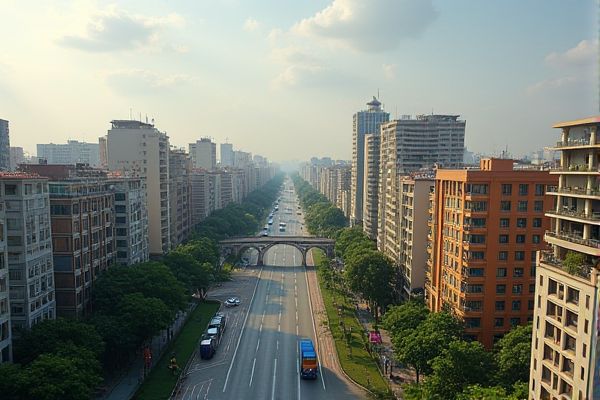
Education system and best schools in India: CBSE, ICSE, and State Boards available. Top international schools in metropolitan cities. Kendriya Vidyalayas for Central Government employees' children. Curriculum focuses on academics and extracurriculars. National Talent Search Examination (NTSE) for scholarships. Indian Institutes of Technology (IITs) are prestigious. Required languages: English and regional language. Montessori and alternative education options exist. Annual academic sessions differ by region. Private schools often have better infrastructure.
CBSE, ICSE, and State Boards available.
The education system in India is managed at central, state, and local levels, with key boards including the Central Board of Secondary Education (CBSE), Indian Certificate of Secondary Education (ICSE), and State Boards. CBSE is the most extensively recognized, offering a standardized curriculum across the country, while ICSE provides a more comprehensive education with a broader range of subjects, and State Boards offer region-specific curricula.
Top international schools in metropolitan cities.
The top international schools in India's metropolitan cities include Rustomjee Cambridge International School in Mumbai, Ecole Mondiale World School in Mumbai, The British School in Delhi, Pathways School in Noida, and Indus International School in Pune, each offering world-class education with various curricula such as IGCSE and IB, and providing advanced facilities for overall student development. To explore a more comprehensive list of these prestigious institutions, you can visit the Top 10 International Schools in India page on Leverage Edu's website, where detailed insights into the programs, philosophies, and environments of each school are offered to assist parents and students in making informed decisions.
Kendriya Vidyalayas for Central Government employees' children.
Kendriya Vidyalayas are a system of central government schools in India, established under the Ministry of Education, providing a uniform curriculum and education to children of central government employees, including defence personnel. Recognized for their excellent infrastructure, academic performance, and co-curricular activities, these schools encompass 1,253 locations within India and three abroad. For more information, you can visit the official Kendriya Vidyalaya website.
Curriculum focuses on academics and extracurriculars.
The Indian curriculum is comprehensive and structured, emphasizing academic excellence in core subjects like mathematics, science, and languages. It also incorporates extracurricular activities such as sports, music, art, and physical education to ensure holistic development and moral education. For a deeper understanding of the educational frameworks, it's insightful to explore the Indian Curriculum vs British Curriculum to compare their unique approaches to fostering student growth.
National Talent Search Examination (NTSE) for scholarships.
The National Talent Search Examination (NTSE) is a prestigious national-level scholarship program conducted by the National Council of Educational Research and Training (NCERT) to identify and reward talented 10th-grade students, providing financial support from Class XI to post-doctoral studies and enhancing their academic and professional prospects. The exam is held in two stages: Stage I at the state level and Stage II at the national level, with scholarships awarded to successful candidates. For more detailed information about this program, visit the NTSE website.
Indian Institutes of Technology (IITs) are prestigious.
The Indian Institutes of Technology (IITs) are highly prestigious engineering and technology institutes in India, known for their selective admissions and significant contributions to India's economic and social development. Established under the Institutes of Technology Act (1961), the IITs have produced many successful CEOs, entrepreneurs, and innovators globally.
Required languages: English and regional language.
In India's education system, students are required to learn English along with their regional language and often a third language, typically Hindi, to foster a connection to cultural heritage, enhance cognitive abilities, and ensure proficiency in English for international communication. This multilingual approach not only broadens students' linguistic capabilities but also promotes a deeper understanding of their own cultural identity. For a more detailed exploration of this topic, you can visit Vernacular Medium, which delves into the impact of regional languages on English language development in India.
Montessori and alternative education options exist.
India offers various alternative education options, including schools inspired by philosophers like Jiddu Krishnamurti and Mahatma Gandhi, such as Rishi Valley School and Ukti, which focus on holistic development, practical learning, and individual autonomy. Though none specifically mentioned are Montessori schools, these alternative schools often incorporate unique curricula and teaching methods. Programs like the Waldorf program are designed to foster a more engaging and experiential learning environment.
Annual academic sessions differ by region.
In India, while the overall structure of the education system is standardized, regional differences in educational attainment and policies can lead to variations in how education is implemented. However, the annual academic sessions themselves do not differ significantly by region, as Primary and Secondary Education follow a uniform framework across the country, with primary education starting at age 6 and secondary education beginning in grade 9.
Private schools often have better infrastructure.
Private schools in India often have better infrastructure, including classrooms, laboratories, libraries, and basic amenities like toilets and drinking water, which contributes to higher student learning outcomes and more efficient management compared to public schools. Investing in quality infrastructure is crucial for fostering an environment conducive to learning. The Importance Of School Infrastructure In Education cannot be overstated as it directly impacts student engagement and academic success. Enhanced facilities not only provide a comfortable learning space but also encourage participation and reduce dropout rates, thereby playing a significant role in shaping the future of education. It is imperative that policymakers and educational authorities prioritize infrastructure development to bridge the gap between private and public schooling experiences.
